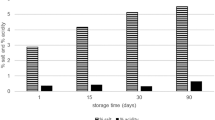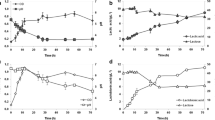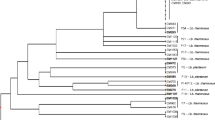Abstract
Scotta is the main by-product in the making of ricotta cheese. It is widely produced in southern Europe and particularly in Italy where it represents a serious environmental pollutant due to its high lactose content. With the aim of evaluating whether scotta bioconversion into lactic acid can be considered as an alternative to its disposal, besides providing it with an added value, here the growth, fermentative performances, and lactic acid productions of pure and mixed cultures of Lactobacillus casei, Lactobacillus helveticus, and Streptococcus thermophilus were evaluated on ovine scotta-based media, without and with the addition of nutritional supplements. The outcomes indicate that ovine scotta can be utilized for the biotechnological production of lactic acid with yields up to 92%, comparable to those obtained on cheese-whey. Indeed, the addition of nutritional supplements generally improves the fermentative performances of lactic acid bacteria leading to about 2 g l−1 h−1 of lactic acid. Moreover, the use of mixed cultures for scotta bioconversion reduces the need for nutritional supplements, with no detrimental effects on the productive parameters compared to pure cultures. Finally, by using L. casei and S. thermophilus in pure and mixed cultures, up to 99% optically pure l-lactic acid can be obtained.




Similar content being viewed by others
References
Amrane A, Prigent Y (1993) Influence of media composition on lactic acid production. Biotechnol Lett 36:461–464
Büyükkileci AO, Harsa S (2004) Batch production of L(+) lactic acid from whey by Lactobacillus casei (NRRL B-441). J Chem Technol Biotechnol 79:1036–1040
Chiarini L, Mara L, Tabacchioni S (1992) Influence of growth supplements on lactic acid production in whey ultrafiltrate by Lactobacillus helveticus. Appl Microbiol Biotechnol 15:239–244
Commission Regulation (EC) No 79/2005, of 19 January 2005 implementing Regulation (EC) No 1774/2002 of the European Parliament and of the Council as regards the use of milk, milk-based products and milk-derived products, defined as Category 3 material in that Regulation. Off J Eur Union L 16:46–50
Datta R, Henry M (2006) Lactic acid: recent advances in products, processes and technologies—a review. J Chem Technol Biotechnol 81:1119–1129
Fitzpatrick JJ, Ahrens M, Smith S (2001) Effect of manganese on Lactobacillus casei fermentation to produce lactic acid from whey permeate. Process Biochem 36:671–675
Fitzpatrick JJ, Murphy C, Mota FM, Pauli T (2003) Impurity and cost considerations for nutrient supplementation of whey permeate fermentations to produce lactic acid for biodegradable plastics. Int Dairy J 13:575–580
Hickey MW, Hillier AJ, Jago GR (1986) Transport and metabolism of lactose, glucose, and galactose in homofermentative Lactobacilli. Appl Environ Microbiol 51:825–831
Hofvendahl K, Hahn-Hagerdal B (2000) Factors affecting the fermentative lactic acid production from renewable resources. Enzyme Microbial Technol 26:87–107
Hujanen M, Linko YY (1996) Effect of temperature and various nitrogen sources on L (+)-lactic acid production by Lactobacillus casei. Appl Microbiol Biotechnol 45:307–313
Iyer R, Tomar SK, Maheswari TU, Singh R (2010) Streptococcus thermophilus strains: multifunctional lactic acid bacteria. Int Dairy J 20:133–141
John RP, Nampoothiri KM, Pandey A (2007) Fermentative production of lactic acid from biomass: an overview on process developments and future perspectives. Appl Microbiol Biotechnol 74:524–534
Lee KB (2005) Comparison of fermentative capacities of Lactobacilli in single and mixed culture in industrial media. Process Biochem 40:1559–1564
Mucchetti G, Carminati D, Pirisi A (2002) Fresh ricotta cheese from cow’s and ewe milk. Observations on production techniques and the product. Il Latte 27:154–166
Nampoothiri KM, Nair NR, John RP (2010) An overview of the recent developments in polylactide (PLA) research. Bioresour Technol 101:8493–8501
Paster M, Pellegrino JL, Carole TM (2003) Industrial bioproducts: today and tomorrow. Energetics, Incorporated, Columbia, Maryland for the US Department of Energy, Office of Energy Efficiency and Renewable Energy, Office of the Biomass Program, Washington, DC
Panesar PS, Kennedy JF, Gandhi DN, Bunko K (2007) Bio-utilisation of whey for lactic acid production. Food Chem 105:1–14
Pescuma M, Hébert EM, Mozzi F, Font de Valdez G (2008) Whey fermentation by thermophilic lactic acid bacteria: evolution of carbohydrates and protein content. Food Microbiol 25:442–451
Pintado ME, Lopes da Silva JA, Malcata FX (1999) Comparative characterization of whey protein concentrates from ovine, caprine and bovine breeds. Lebensm Wiss Technol 32:231–237
Plessas S, Bosnea L, Psarianos C, Koutinas AA, Marchant R, Banat IM (2008) Lactic acid production by mixed cultures of Kluyveromyces marxianus, Lactobacillus delbrueckii ssp. bulgaricus and Lactobacillus helveticus. Bioresour Technol 99:5951–5955
Roukas T, Kotzekidou P (1998) Lactic acid production from deproteinized whey by mixed cultures of free and co-immobilized Lactobacillus casei and Lactococcus lactis cells using fedbatch culture. Enzyme Microbial Technol 22:199–204
Sansonetti S, Curcio S, Calabrò V, Iorio G (2009) Bio-ethanol production of ricotta cheese-whey as an effective alternative non-vegetable source. Biomass Bioenerg 33:1687–1692
Sansonetti S, Curcio S, Calabrò V, Iorio G (2010) Optimization of ricotta cheese-whey (RCW) fermentation by response surface methodology. Bioresour Technol 101:9156–9162
Sauer M, Porro D, Mattanovich D, Branduardi P (2008) Microbial production of organic acids: expanding the markets. Trends Biotechnol 26:100–108
Schepers AW, Thibault J, Lacroix C (2002) Lactobacillus helveticus growth and lactic acid production during pH-controlled batch cultures in whey permeate/yeast extract medium. Part I. multiple factor kinetic analysis. Enzyme Microbial Technol 30:176–186
Shen L, Haufe J, Patel MK (2009) Scenarios for markets of bio-based plastics. In: Product overview and market projection of emerging bio-based plastics. Utrecht University. www.europeanbioplastics.org/wpcontent/uploads/2011/03/publications/PROBIP2009_Final_June_2009.pdf. Accessed 19 May 2011
Tejayadi S, Cheryan M (1995) Lactic acid from cheese-whey permeate. Productivity and economics of a continuous membrane bioreactor. Appl Microbiol Biotechnol 43:242–248
Wee YJ, Kim JN, Ryu HW (2006) Biotechnological production of lactic acid and its recent applications. Food Technol Biotechnol 44:163–172
Acknowledgments
This study was a part of the project “WHETLAC”, financed by the European Commission under contract No 222400. We also acknowledge the F.lli Pinna Industria Casearia for providing the ovine scotta and Dr. Elia Bonaglini for his support.
Author information
Authors and Affiliations
Corresponding author
Rights and permissions
About this article
Cite this article
Secchi, N., Giunta, D., Pretti, L. et al. Bioconversion of ovine scotta into lactic acid with pure and mixed cultures of lactic acid bacteria. J Ind Microbiol Biotechnol 39, 175–181 (2012). https://doi.org/10.1007/s10295-011-1013-9
Received:
Accepted:
Published:
Issue Date:
DOI: https://doi.org/10.1007/s10295-011-1013-9




